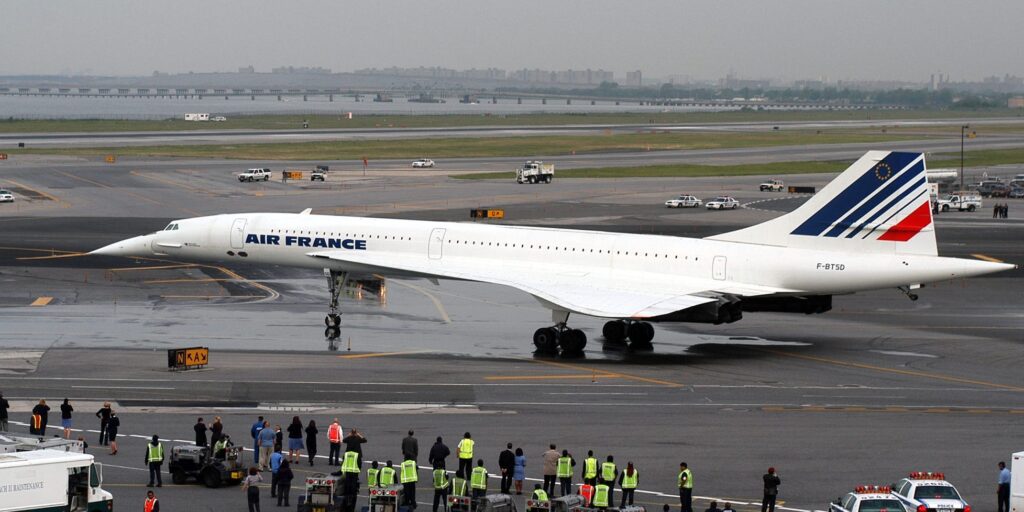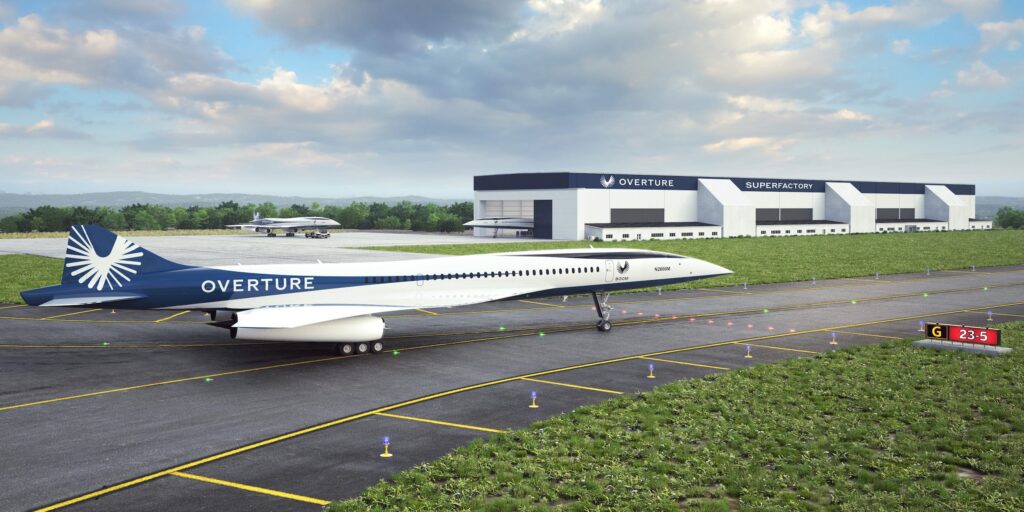- Aerospace company Boom Supersonic is working to develop a new supersonic passenger jet.
- The Overture is designed to carry 88 people and fly across the Atlantic in less than four hours.
- Some experts say the production timeline and the commercial viability of the Overture are ambitious.
Colorado aerospace company Boom Supersonic is building the world's latest faster-than-sound passenger plane, called the Overture.
Humans haven't experienced supersonic commercial air travel since the famous Concorde retired in 2003. The jet could rocket across the Atlantic in less than four hours at speeds up to 1,340 mph but was retired due to expensive operating costs and a high-profile crash.
Twenty-one years later, Boom celebrated the "return of a civil supersonic aircraft to the skies" when it flew its first prototype in March 2023.

The XB-1 "baby boom" — created to test supersonic-specific flight technologies — zoomed for 12 minutes at speeds reaching 273 mph and altitudes up to 7,120 feet.
The tinier jet's performance represents just a fraction of what Boom's $200 million plane is expected to fly. The company expects regulatory approvals for passenger flights in the Mach-1.7 jet by 2029 and has already garnered 130 orders from carriers, including American Airlines, Japan Airlines, and United Airlines.
That timeline has some aviation experts raising their eyebrows, given the tricky commercial market for such a service.
"We recognize this target timeline is ambitious, but we challenge ourselves and our suppliers, who share our vision for a sustainable, supersonic future, to meet ambitious goals," Boom told BI, noting it will "actively assess" its schedule as the program moves forward.
Overture has a laundry list of challenges to overcome
University of Illinois aerospace engineering professor Michael Bragg told Business Insider that high costs and overland flight restrictions because of sonic booms could hinder the production and certification of Overture
He estimated Boom's plane would likely cost less to operate than the Concorde, but would still struggle to find people willing to pay the high ticket price. Seats on the Concorde went for around $12,000 round trip in the 1970's, according to Simple Flying.

"I'm surprised Boom is pushing toward the commercial airline market," Bragg told BI. "10 or 15 years ago, the focus was more on corporate jets because it's less cost-sensitive. Perhaps there's a larger market in commercial — there would be if Boom can get the cost down."
There's also the challenge of the sonic boom, Bragg said. US law presently bans all supersonic flight over land due to the noise, he explained, meaning Mach-speed planes can only fly over water until that is changed.
Bragg said a supersonic plane would be much more effective if it could be used on cross-country flights rather than just transoceanic.
"If you aren't able to accomplish that, then making it financially is going to be much more difficult," Bragg said.
Boom told Business Insider in an emailed statement that the company has identified "more than 600 profitable and mostly transoceanic routes" that Overture could fly, noting the speed of the jet will allow for more revenue flights in one day compared to subsonic planes.

Boom also said that "Overture will only break the sound barrier over water," and the company is building noise mitigation technologies to ensure the ultra-speedy jet maintains acceptable noise levels over land. According to Boom, Overture will be able to fly Mach 0.94 over land, which is "20% faster than subsonic flight."
"Based on extensive passenger research, we know that passengers will pay an average premium of 55% for less time in the air," Boom said.
Experts point to design challenges surrounding the jet's airframe and engines
Bragg said that Overture's four rear engines and unique airframe will require innovative systems to ensure safety and efficiency.
For example, he said the pilots would need a computer-vision system to see beyond the plane's nose during its high-angle-of-attack takeoffs and landings, while the delta wing design would need a robust ice protection system to meet safety standards.
For visibility issues, XB-1 is already testing an augmented-reality vision system that feeds video from nose-mounted cameras and information into the cockpit.

Regarding ice, Boom said its ice-prone surfaces would go through the required rigorous testing and analysis to "comply with the most stringent safety and certification requirements."
It noted, however, that Overture's delta wings are "inherently less sensitive" to the risk of losing lift due to ice accumulation on the wing compared to conventional subsonic wings.
Another challenge Bragg noted is that Boom has been forced to build its own engine for Overture in-house after the world's major engine makers, like Rolls-Royce and Pratt & Whitney, opted out.
Boom told BI that its purpose-built and "economically sustainable" engine, called Symphony, is the "best approach" for its customers.
"Symphony is expected to deliver a 25% increase in time on wing and significantly lower engine maintenance costs, reducing overall airplane operating costs for airline customers by 10%," Boom said.
Aviation analyst Henry Hardevelt previously told BI that the task of building Overture is "hard enough," and adding the engine to the mix would be a "big challenge." However, he said the homemade powerplant could prove lucrative should Boom succeed and sell the design.
Bragg said the overall main concern, however, is the fact that the Overture is a brand new plane that will take a lot of time to prove and certify, saying there will likely the several "hiccups" along the way.
"I think everyone is excited to see a new supersonic jetliner," he said, noting the Mach-speed goal is achievable given the Concorde and the US' ultra-speedy military jets. "But Boom wants to develop, manufacture, and test Overture and create a new engine in six years. That's ambitious, and alone seems extremely optimistic to me, but there would need to be very patient capital."
